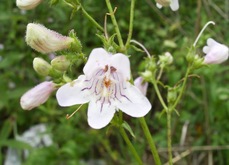|
My Master's thesis is available for download through the University of Tennessee. The abstract is posted below. Below the abstract, I have provided links to my nucleotide and codon datasets. Due to a technicality, the thesis title only describes the second part of the study. Also, please note that the thesis is published under my maiden name (Becker). |
Genetic variation and dispersal in Penstemon hirsutus and P. tenuiflorus.
Abstract
Studying plant-pollinator relationships is essential for understanding angiosperm evolution. In the large endemic genus Penstemon (Plantaginaceae), shifts in pollination syndrome are proposed to be important for explaining taxonomic and morphological diversity (Wilson et al., 2004; Wolfe et al., 2006). However, little work has been done to determine the relationship between morphological and genetic divergence within pollination syndromes. This study utilized genetic data to explore whether divergence in corolla morphology among nine closely related, bee pollinated Penstemon species* was consistent with pollinator-driven selection.
Bee pollinated species in Penstemon subsection Penstemon are often divided into two morphological groups based on inflation of the corolla throat. This trait has been proposed to be an important target for pollinator selection (Pennell, 1935; Clements, 1995). Consistent with this theory, phylogenetic analyses of the nuclear granule-bound starch synthase gene (GBSSI) indicated that genetic divergence among species was consistent with morphological divergence. However, a similar pattern was reflected by the noncoding chloroplast region rps16-trnK, indicating divergence likely occurred during a period of geographic isolation. Therefore, pollinator-driven selection on corolla morphology does not appear to be the primary cause of divergence among morphological groups. Instead, gene flow patterns indicate that pollinator selection may serve to reinforce pre-existing divergence between groups.
Population genetic analyses utilized microsatellites in addition to GBSSI and rps16-trnK and focused specifically on two species that share a high degree of morphological similarity. Penstemon hirsutus and P. tenuiflorus have small average population sizes, fragmented geographic distributions and are pollinated by insects (primarily bees) with short foraging ranges. Patterns consistent with geographic isolation of populations were observed in P. hirsutus, but P. tenuiflorus nuclear data reflected much lower levels of genetic structure. Although P. hirsutus and P. tenuiflorus are highly similar, these findings imply that pollinator dynamics differ between species. Therefore, a trait other than corolla throat inflation may be important for explaining differences in pollinator-driven selection. Furthermore, P. tenuiflorus may represent an example of Slatkin’s paradox. Higher than expected pollen-mediated gene flow among populations of P. tenuiflorus suggest that long-distance foragers such as moths may be more important than previously realized.
*Penstemon australis, P. brevisepalus, P. canescens, P. calycosus, P. digitalis, P. hirsutus, P. laevigatus, P. pallidus and P. tenuiflorus. Single accessions from four other species were also included: Penstemon apateticus, P. oklahomensis, P. roseus and Chionophila jamesii.
Download my thesis:
http://trace.tennessee.edu/utk_gradthes/1592/
Download or view my nucleotide and codon datasets (via NCBI):
chloroplast intergenic spacer (rps16-trnK) nucleotide dataset
nuclear gene (GBSSI) nucleotide and codon dataset
Bee pollinated species in Penstemon subsection Penstemon are often divided into two morphological groups based on inflation of the corolla throat. This trait has been proposed to be an important target for pollinator selection (Pennell, 1935; Clements, 1995). Consistent with this theory, phylogenetic analyses of the nuclear granule-bound starch synthase gene (GBSSI) indicated that genetic divergence among species was consistent with morphological divergence. However, a similar pattern was reflected by the noncoding chloroplast region rps16-trnK, indicating divergence likely occurred during a period of geographic isolation. Therefore, pollinator-driven selection on corolla morphology does not appear to be the primary cause of divergence among morphological groups. Instead, gene flow patterns indicate that pollinator selection may serve to reinforce pre-existing divergence between groups.
Population genetic analyses utilized microsatellites in addition to GBSSI and rps16-trnK and focused specifically on two species that share a high degree of morphological similarity. Penstemon hirsutus and P. tenuiflorus have small average population sizes, fragmented geographic distributions and are pollinated by insects (primarily bees) with short foraging ranges. Patterns consistent with geographic isolation of populations were observed in P. hirsutus, but P. tenuiflorus nuclear data reflected much lower levels of genetic structure. Although P. hirsutus and P. tenuiflorus are highly similar, these findings imply that pollinator dynamics differ between species. Therefore, a trait other than corolla throat inflation may be important for explaining differences in pollinator-driven selection. Furthermore, P. tenuiflorus may represent an example of Slatkin’s paradox. Higher than expected pollen-mediated gene flow among populations of P. tenuiflorus suggest that long-distance foragers such as moths may be more important than previously realized.
*Penstemon australis, P. brevisepalus, P. canescens, P. calycosus, P. digitalis, P. hirsutus, P. laevigatus, P. pallidus and P. tenuiflorus. Single accessions from four other species were also included: Penstemon apateticus, P. oklahomensis, P. roseus and Chionophila jamesii.
Download my thesis:
http://trace.tennessee.edu/utk_gradthes/1592/
Download or view my nucleotide and codon datasets (via NCBI):
chloroplast intergenic spacer (rps16-trnK) nucleotide dataset
nuclear gene (GBSSI) nucleotide and codon dataset

